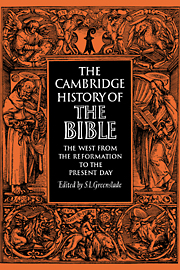3 results in The Cambridge History of the Bible

The Cambridge History of the Bible
-
- Published online:
- 28 March 2008
- Print publication:
- 01 April 1970

The Cambridge History of the Bible
-
- Published online:
- 28 March 2008
- Print publication:
- 02 October 1963

The Cambridge History of the Bible
-
- Published online:
- 28 March 2008
- Print publication:
- 02 May 1969

